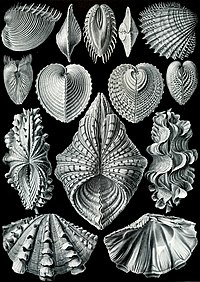
High-Resolution Melting of 18S rDNA sequences (18S-HRM) for discrimination of bivalve’s species at early juvenile stage: application to a spat survey
Sign Up to like & getrecommendations! Published in 2017 at "Marine Biology"
DOI: 10.1007/s00227-017-3162-5
Abstract: It is particularly difficult to identify bivalve species at early development stages (larvae and spat) by morphological examination. Targeting genetic marker commonly used for species identification, we developed a cheap and user friendly tool for… read more here.
Keywords: species early; high resolution; bivalve; bivalve species ... See more keywords

Effects of marine harmful algal blooms on bivalve cellular immunity and infectious diseases: A review.
Sign Up to like & getrecommendations! Published in 2020 at "Developmental and comparative immunology"
DOI: 10.1016/j.dci.2020.103660
Abstract: Bivalves were long thought to be "symptomless carriers" of marine microalgal toxins to human seafood consumers. In the past three decades, science has come to recognize that harmful algae and their toxins can be harmful… read more here.
Keywords: bivalve; infectious diseases; marine harmful; disease ... See more keywords

Risky behaviours from the production to the consumption of bivalve molluscs: Involving stakeholders in the prioritization process based on consensus methods
Sign Up to like & getrecommendations! Published in 2017 at "Food Control"
DOI: 10.1016/j.foodcont.2017.03.010
Abstract: Abstract The most recent data show that shellfish farming represents approximately 60% of the total aquaculture production in Europe. Bivalves molluscs are internationally recognized as a potential vehicle for foodborne diseases especially when consumed raw… read more here.
Keywords: consensus methods; production; bivalve; behaviours production ... See more keywords

Morphological evolution of the bivalve Ptychomya through the Lower Cretaceous of Argentina
Sign Up to like & getrecommendations! Published in 2018 at "Paleobiology"
DOI: 10.1017/pab.2017.32
Abstract: Abstract. The complex morphological evolution of the bivalve Ptychomya throughout the well-studied Agrio Formation in the Neuquén Basin (west-central Argentina, lower/upper Valanginian-lowest Barremian) constitutes an ideal opportunity to study evolutionary patterns and processes occurring at… read more here.
Keywords: evolution bivalve; bivalve; evolution; morphological evolution ... See more keywords

Bivalve borings in Lower Jurassic Lithiotis fauna from northeastern Italy and its palaeoecological interpretation
Sign Up to like & getrecommendations! Published in 2017 at "Historical Biology"
DOI: 10.1080/08912963.2016.1265956
Abstract: Abstract Random shell sections of the Pliensbachian (Early Jurassic) larger bivalve Opisoma from columns within the Main Post Office building of Ferrara, northern Italy, have been discovered to bear neat clavate-shape boreholes. These boreholes belong… read more here.
Keywords: lithiotis fauna; borings lower; bivalve; bivalve borings ... See more keywords

Evolutionary conservation and divergence of the transcriptional regulation of bivalve shell secretion across life-history stages
Sign Up to like & getrecommendations! Published in 2022 at "Royal Society Open Science"
DOI: 10.1098/rsos.221022
Abstract: Adult molluscs produce shells with diverse morphologies and ornamentations, different colour patterns and microstructures. The larval shell however, is a phenotypically more conserved structure. How do developmental and evolutionary processes generate varying diversity at different… read more here.
Keywords: shell secretion; life history; shell; bivalve ... See more keywords

Specimen alignment with limited point-based homology: 3D morphometrics of disparate bivalve shells (Mollusca: Bivalvia)
Sign Up to like & getrecommendations! Published in 2022 at "PeerJ"
DOI: 10.1101/2022.03.04.482893
Abstract: Comparative morphology fundamentally relies on the orientation and alignment of specimens. In the era of geometric morphometrics, point-based homologies are commonly deployed to register specimens and their landmarks in a shared coordinate system. However, the… read more here.
Keywords: alignment; mollusca bivalvia; homology; point based ... See more keywords

Facilitating foundation species: The potential for plant–bivalve interactions to improve habitat restoration success
Sign Up to like & getrecommendations! Published in 2020 at "Journal of Applied Ecology"
DOI: 10.1111/1365-2664.13605
Abstract: 1. Vegetated marine and freshwater habitats are being increasingly lost around the world. Habitat restoration is a critical step for conserving these valuable habitats, but new approaches are needed to increase restoration success and ensure… read more here.
Keywords: habitat restoration; bivalve; plant; restoration success ... See more keywords

Speeding up the detection of invasive bivalve species using environmental DNA: A Nanopore and Illumina sequencing comparison
Sign Up to like & getrecommendations! Published in 2022 at "Molecular Ecology Resources"
DOI: 10.1111/1755-0998.13610
Abstract: Traditional detection of aquatic invasive species via morphological identification is often time‐consuming and can require a high level of taxonomic expertise, leading to delayed mitigation responses. Environmental DNA (eDNA) detection approaches of multiple species using… read more here.
Keywords: detection invasive; species using; detection; environmental dna ... See more keywords

Past, Present, and Future: Performance of Two Bivalve Species Under Changing Environmental Conditions
Sign Up to like & getrecommendations! Published in 2018 at "Frontiers in Marine Science"
DOI: 10.3389/fmars.2018.00184
Abstract: Globally, the production of marine bivalves has been steadily increasing over the past several decades. As the effects of human population growth are magnified, bivalves help provide food security as a source of inexpensive protein.… read more here.
Keywords: bivalve; physiology; climate change; performance ... See more keywords

The Vibriolysin-Like Protease VnpA and the Collagenase ColA Are Required for Full Virulence of the Bivalve Mollusks Pathogen Vibrio neptunius
Sign Up to like & getrecommendations! Published in 2021 at "Antibiotics"
DOI: 10.3390/antibiotics10040391
Abstract: Vibrio neptunius is an important pathogen of bivalve mollusks worldwide. Several metalloproteases have been described as virulence factors in species of Vibrio that are pathogenic to bivalves, but little is known about the contribution of… read more here.
Keywords: bivalve; virulence; collagenase; vnpa ... See more keywords